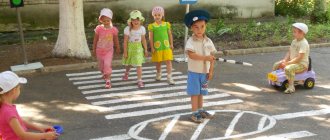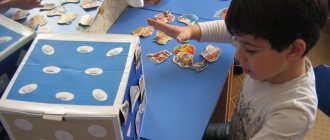Didactic game “Yesterday, today, tomorrow”
Goal: to develop children’s ability to navigate time, to consolidate the concepts of “yesterday”, “today”, “tomorrow”.
Material: multi-colored stripes, a selection of poems.
Progress of the game: the teacher explains that every day, in addition to its name, has another name (yesterday, today, tomorrow).
The day that has come is called today.
A day that has already ended is yesterday.
And the day that is yet to come is tomorrow.
We designate the colors (stripes): today – blue, yesterday – blue, tomorrow – purple.
First, we fix the color designation: the teacher names the concepts, the children show the corresponding strip.
Then the teacher reads the poem, the children determine what day the poem is about (yesterday, today, tomorrow) and show the corresponding strip.
Ball game "Yesterday, today, tomorrow"
Goal: to develop children’s ability to navigate time, to consolidate the concepts of “yesterday”, “today”, “tomorrow”.
Material: ball
Progress of the game: the teacher throws the ball to the children one by one, saying a short phrase, for example, “We are doing...” The child who caught the ball finishes the phrase (... today).
Example phrases:
We are going to walk…
Did you go to the park...
We will read a book...
Didactic game “Colorful week”
Goal: to consolidate ideas about the days of the week, to consolidate the names and sequence of the days of the week, to develop navigation skills in the days of the week.
Material: multi-colored circles, numbers from 1 to 7.
Progress of the game: the teacher on the demonstration circle indicates the color and names the day of the week, the children show the corresponding number.
Option 1: the teacher shows the numbers from 1 to 7 in order, the children show the corresponding color on their circles and name the day of the week.
Didactic game “Week, line up”
Goal: to consolidate ideas about the days of the week, to consolidate the names and sequence of the days of the week, to develop navigation skills in the days of the week.
Material: numbers 1-7.
How to play: There are upside-down cards with numbers on the table. Children take cards from the table at a signal. They look for their partners, that is, they line up in order and name their day of the week (“The first is Monday, the second is Tuesday...).
Tasks:
1. The teacher asks to leave the day that represents Monday;... Wednesday, etc.
2. The teacher asks for the day of the week that comes after Monday, before Saturday, between Tuesday and Thursday, etc.
3. The teacher asks to come out the days of the week that are after Thursday (children with the numbers five, six, seven come out); before Wednesday (children with numbers one, two) and name their days of the week.
Ball game “Catch, throw, name the days of the week”
Goal: to consolidate ideas about the days of the week, to consolidate the names and sequence of the days of the week, to develop navigation skills in the days of the week.
Material: ball.
Progress of the game: children form a circle. The teacher stands in the middle of the circle. He throws a ball to one of the children and says: “What day of the week is today?” The child who caught the ball answers: “Tuesday.” Then the teacher throws the ball to another child and asks a question like: “What day of the week was yesterday?”
Question options:
Name the day of the week after Thursday. Name the day of the week between Thursday and Friday, etc.
If someone finds it difficult to quickly give an answer, the teacher invites the children to help him.
Ball game “It happens - it doesn’t happen”
Goal: to develop verbal and logical thinking, to consolidate ideas about the signs of the seasons.
Material: ball.
Progress of the game: the players stand in a circle. The teacher names a sign of a certain time of year. The child catches the ball if this sign is appropriate.
Exercise “Repeat, don’t make a mistake”
Goal: to consolidate the names of the months (according to the seasons).
Progress of the game: the child names the names of the autumn (winter, spring...) months in order, with or without pictures.
Ball game "Carry on"
Goal : develop time orientation skills, consolidate the ability to name the signs of the seasons.
Material: ball
Progress of the game: children and the teacher stand in a circle, the teacher names the season and gives the ball to the child, the children name the signs of this season and pass the ball around the circle.
GCD in the senior group. Getting to know the days of the week
Direct educational activity “Introducing children of senior preschool age to the days of the week.”
Objectives: To introduce children to the names and the sequence of days of the week. Fix the names and sequence of days of the week in children’s active speech. Teach children to visually lay out the days of the week in a certain sequence. Continue teaching ordinal counting. Develop attention, memory, thinking. Continue teaching children to name the colors of the spectrum. Equipment : Demonstrative material: “Grid-week”, cards with numbers (from 1 to 7), colored cards (K, O, F, Z, G, S, F); the same handout depending on the number of children present.
Progress of the lesson:
A week grid hangs on the board. • What's on the board? How do you think? • Let's count the LINES? How many are there? (7) • Does this number tell you anything? • Let's remember our favorite fairy tales, in which fairy tales does the number 7 appear? (7 KIDS, SEVEN-FLOWER FLOWER, SNOW WHITE AND THE SEVEN Dwarfs) • Where in life can we meet the number 7? (7 WONDERS OF THE WORLD, 7 DAYS A WEEK, 7 COLORS OF THE RAINBOW) Guess the riddle: THERE ARE EXACTLY SEVEN THESE BROTHERS. YOU ALL KNOW THEM. EVERY WEEK THE BROTHERS WALK AROUND EACH OTHER, THE LAST ONE GOES AWAY - THE ONE IN FRONT APPEARS. (DAYS OF THE WEEK) • maybe someone knows the name of each of the brothers? (Mon, Tue, Wed….) Now let’s get back to our grid. These guys are not just a grid, but a weekly grid, it will help us remember the days of the week. • Why do you think we need to know the days of the week? (in order to know when it’s a day off and not to come to kindergarten, to know when and what day of classes, we go to music classes on Mon and Wed, that is, on certain days) • Haven’t you thought why ours are those brothers names? But because (SHOW THE NAMES ON YOUR HAND and at the same time fill the grid in order with numbers) MONDAY is the first after the week, after the weekend. TUESDAY - second, WEDNESDAY - who knows why? BECAUSE HE'S IN THE MIDDLE! FRIDAY, SATURDAY AND SUNDAY – ON THE OTHER HAND BECAUSE THEY ARE WEEKENDS!! • Guys, now let’s fill out our “WEEK”, and each, every day we will designate with a color: MON – RED TUE – ORANGE WE – YELLOW Thu – GREEN FRI – BLUE SAT – BLUE SUN – PURPLE • Well, what a beautiful WEEK we have? • Is there something missing here? Well, of course, who can tell me what classes we have……………..? (mark with symbols the activities that should be) Physical exercise: On Monday we did the laundry, On Tuesday we swept the floor, On Wednesday we baked kalach, We played ball all Thursday, On Friday we washed cups, And on Saturday we bought cake And of course on Sunday Invited everyone to the birthday party, sang, jumped, danced, counted the days of the week! Reflection. And now everyone has their own WEEK on their tables! you need to fill in the empty cells just like we did on the board. Don't forget that each day has its own serial number and its own assigned color!
We recommend watching:
GCD summary for the perception of music in the senior group of kindergarten GCD for children of the senior group: Culture and traditions of the Mordovian people GCD summary for drawing in the senior group on the topic: Winter Model of a program for introducing older preschoolers to the works of Konashevich
Similar articles:
Lesson in the senior group of kindergarten on the topic of February 23
Lesson notes for children of senior preschool age. Topic: Invisible air
Summary of organized educational activities for children of the senior group
Notes for mathematics classes in the senior group
Lesson summary on the topic “Reserve” in the senior group
Preparatory group
For preschoolers aged 6-7 years, more complex educational games are provided that develop logic and thinking abilities.
Hide and seek
Tell the students that the days of the week wanted to play hide and seek. But there is a hint that allows you to quickly find them. Each of them hid behind an object or in a room whose name begins with the same letter as the day. Name this object, and the children must guess the day.
For example:
- hid behind the desk... Monday;
- behind the hanger... Tuesday;
- behind the bench... Wednesday;
- in the attic... Thursday;
- in the hallway... Friday;
- behind the chair... Saturday;
- in the bathroom... Sunday.
Say the word
To play you need a ball. Throw it to the players one by one, asking questions like this:
- on Monday mom works, and on Sunday... she rests;
- Wednesday is followed by... Thursday;
- Tuesday is today, and Wednesday is... tomorrow;
- Today is Friday, and yesterday was... Thursday.








